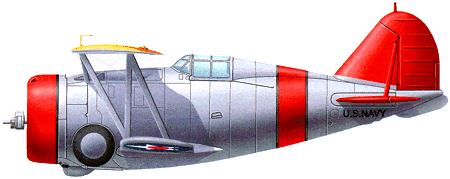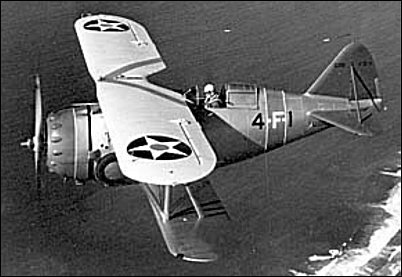|
| Developed from the FF-1, the XF2F-1 prototype single-seat carrier-borne biplane fighter made its first flight just a few months after deliveries began of the earlier type. In terms of performance it was a great improvement over naval fighters then operational and so the US Navy ordered it into production. The F2F-1 production version was powered by the 484.4kW Pratt & Whitney R-1535-72 radial engine, had a neat cockpit canopy which was faired into the rear fuselage and retained the type of retractable landing gear used on the FF-1.

Soon after all F2F-1 had been delivered, Grumman produced a new prototype, the XF3F-1, which flew for the first time in March 1935. This version was slightly larger and production aircraft entered service in the following year. F3F-1 and later F3F-2 were powered by 484.4kW R-1535-84 and 559kW Wright Cyclone engines respectively, although in general construction they were identical to the F2F-1. Maximum level speed of the F3F-2 was 434.5km/h, a clear
48km/h faster than the F3F-1. Altogether a total of 216 F2F/F3F were produced, remaining operational until the latter part of 1939.
| MODEL | F3F-3 |
| CREW | 1 |
| ENGINE | 1 x Wright R-1820-22, 708kW |
| WEIGHTS |
| Take-off weight | 2175 kg | 4795 lb |
| Empty weight | 1490 kg | 3285 lb |
| DIMENSIONS |
| Wingspan | 9.75 m | 32 ft 0 in |
| Length | 7.06 m | 23 ft 2 in |
| Height | 2.84 m | 9 ft 4 in |
| Wing area | 24.15 m2 | 259.95 sq ft |
| PERFORMANCE |
| Max. speed | 425 km/h | 264 mph |
| Cruise speed | 241 km/h | 150 mph |
| Ceiling | 10120 m | 33200 ft |
| Range | 1577 km | 980 miles |
| ARMAMENT | 2 x 7.62mm machine-guns |
 | A three-view drawing of Grumman F3F-1 (1280 x 956) |
| MICHAEL J PASCALE, 08.12.2014 22:00 I am in the process of building this plane out of balsa wood the airplane plans came from Cleveland Models Ohio.The W /S well be 40" This is 1 /16 scale. reply | | Doug R, e-mail, 18.07.2012 16:50 I meant F3F Gulfhawk of course. reply | | Doug R, e-mail, 18.07.2012 16:48 The best movie to see F3F's in is "Dive Bomber" made in I think 1939 and in color! Starring Errol Flynn and Fred MacMurray. The F3F is just as big a star as those actors in the movie. It's neat to see the movie where the F3F's are front line fighters! . I'm not sure if its available on dvd. TV cable shows it once in a while.
Isn't it true that the only surviving F8F is the Al Williams Gulfhawk in the Smithsonian? I think the others around were rebuilt out of wrecks were they used very little of the original airframe.
I have a question, I have never been able to figure out if Navy F3F fuselages were natural varnished aluminum or painted gray. Anyone know? reply | | Mike, 27.06.2011 22:30 This is a really good plane and the F2F-1 has got a Pratt&Whitney R-1535-72 Twin Wasp Junior radial engine.
I think this fighter was the best Grumman Biplane. reply | |
| | Klaatu, e-mail, 19.06.2011 17:39 Incidentally, the purpose of the "V" shaped marking on the upper wing, visible in the photo above, was to aid in formation flying. In the period prior to World War II, military pilots expended a great deal of effort on perfecting their skill at maintaining perfect flying formations. Squadrons often lined up in echelon, or in Vees, stepped upward from the leader, lining up using the painted markings on the wings as visual guides. Of course, all of that sort of thing went out the window once they got into actual combat! reply | | Klaatu, e-mail, 19.06.2011 17:28 There's a motion picture called "Fighter Command", released by MGM in 1940, that featured these aircraft. I believe it's still shown from time to time. It's amazing to think that the Navy still regarded these biplanes as first-line fighters in 1940, but then again, at that same time, the Royal Navy was still operating Sea-Gladiators! reply | | Jackie, 08.08.2010 05:41 The Grumman F3F was the predecessor of the successful F4F Wildcat. Its design was similar to the Wildcat and it was the last biplane delivered to the US Navy, and served between the wars. Designed as an improvement on the single-seat F2F, it entered service in 1936. It was retired from front line squadrons at the end of 1941 before it could serve in World War II, and was first replaced by the Brewster F2A Buffalo. When it entered combat, the Wildcat would quickly replace the Buffalo as the primary fighter of the Navy and Marines in the first part of WWII, and continue to be produced throughout the conflict. reply | | ROGER, e-mail, 17.08.2010 12:07 Pictures are great. How bout talking American. This aircraft worked under Horsepower, and cruised at 257 MILES PER HOUR, and traveled 450 MILES in distance. could dive out to 340 MILES PER HOUR and so on. The landing gear was a chain and sprocket affair requiring so 20 plus turns to retracked it. reply | | Gary Fortington, e-mail, 29.09.2008 00:24 I am trying to locate a photo of Jimmy Collins, test pilot who was contracted by Grumman and killed during the first test flight of the XF3F-1 which took place on March 20, 1935. I understand that Jimmy was also employed by one of my ancestors "Gus" Fortington, an influential figure within Paramount Pictures back in the 1930's.
I hope that you are able to help me or, perhaps, point me towards someone that might be able to.
Cheers
Gary Fortington
Queensland, Australia reply | | Frank Hannegan, e-mail, 25.05.2008 01:51 In 1936 my father was ordered to duty in VF-4, a squadron attached to USS RANGER. This squadron was named "Red Rippers"...the second to have this name in a long and celebrated line. About the time my father arrived the squadron took delivery of the F-3F. Intitial familiarization and trianing was provided by Grumman and a famoous gentleman by the name of Al Williams was the instructor. The first CO during my father's tour of duty was "Gotch" Dillon and shortly he was followed by Wendy Switzer(later a Vice Admiral) reply | | Paul R. Flow, e-mail, 11.05.2008 21:09 I went through Aviation Machinist's Mate School in Millington(near Memphis) in 1943-44. We had some retired F3F's to practice on. It was there on that plane that I learned how to rig the wings on a bi-plane.
In answer to Vladimir's question, The gear cranked up and down with a crank on the right side of the cockpit-just like the F4F /FM-2. reply | | Rob W, 20.12.2007 05:37 I believe this aircraft is in the Naval Air Museum in Pensacola Florida reply | | Art B, e-mail, 21.04.2007 01:44 In which museum in the USA can I see the actual airplane? reply | | Vladimir, e-mail, 26.11.2006 05:11 I've got a question.What is the mechanisme of the gear?Help me,if it is possible reply |
|
Do you have any comments?
|
| 
COMPANY
PROFILE
All the World's Rotorcraft
|









